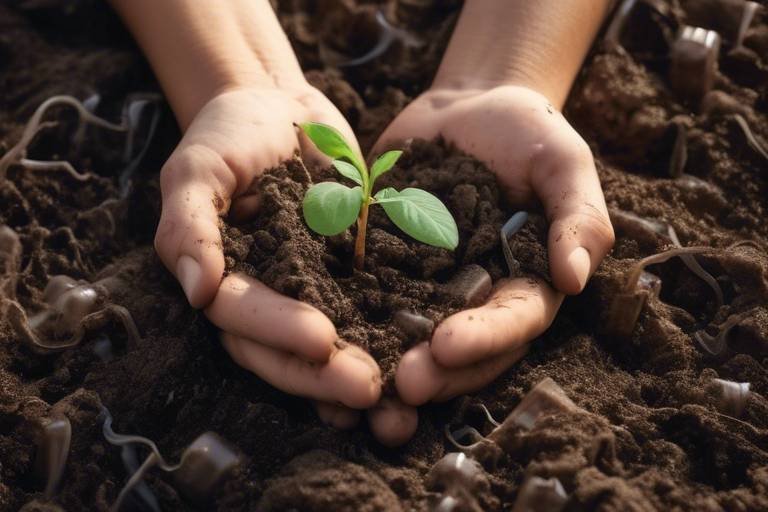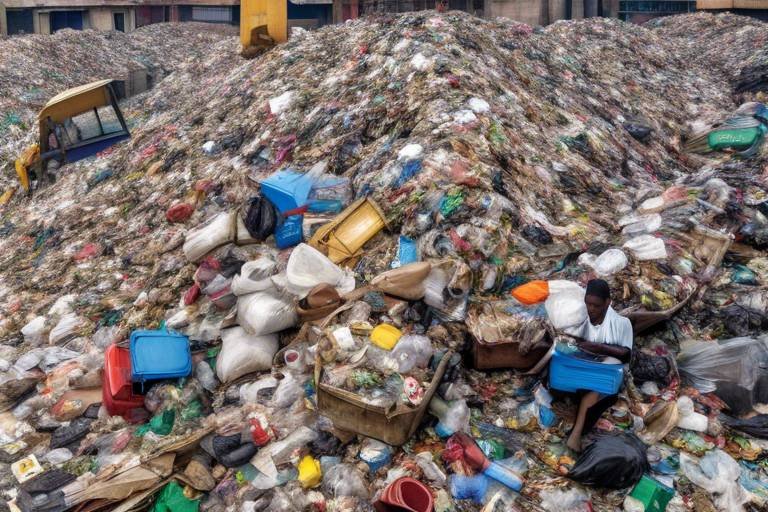Examining the Environmental Impact of Meat Production
The world we live in is intricately connected, and our dietary choices play a significant role in shaping the environment. When we think about meat production, we often picture farms bustling with animals, but the reality is much more complex and concerning. The environmental consequences of meat production are profound and far-reaching, affecting everything from our climate to biodiversity. In this article, we will delve into the various facets of this issue, exploring how our appetite for meat contributes to greenhouse gas emissions, deforestation, water usage, and the loss of biodiversity. Moreover, we will consider sustainable alternatives that could help mitigate these impacts, allowing us to enjoy our meals without compromising the health of our planet.
Did you know that meat production is one of the largest sources of greenhouse gas emissions? It’s true! In particular, the production of beef and lamb generates significant amounts of methane and nitrous oxide, two potent greenhouse gases that are far more effective at trapping heat in the atmosphere than carbon dioxide. Methane is released during digestion in ruminant animals, while nitrous oxide comes from the fertilizers used to grow feed crops. According to the Food and Agriculture Organization (FAO), livestock accounts for around 14.5% of global greenhouse gas emissions. This staggering figure highlights the urgent need for change, as the implications for climate change are dire. As temperatures rise and weather patterns shift, the effects of these emissions ripple through our ecosystems, leading to extreme weather events, rising sea levels, and threats to food security.
Another alarming consequence of meat production is deforestation. As the demand for meat surges, vast areas of forests are cleared to make way for grazing land and feed crop cultivation. This not only leads to habitat loss for countless species but also contributes to carbon emissions, as trees that once absorbed CO2 are cut down. In regions like the Amazon rainforest, the expansion of livestock farming has resulted in the destruction of millions of acres of forest. The loss of these vital ecosystems has profound implications, not just for wildlife, but also for the global climate. When we lose forests, we lose biodiversity, and with it, the delicate balance of our planet's ecosystems.
Speaking of biodiversity, the conversion of natural habitats into agricultural land for meat production poses a serious threat to countless species. Ecosystems are complex webs of life, and when one part is removed, it can lead to cascading effects throughout the system. The loss of forests and grasslands for livestock grazing disrupts the habitats of many animals, leading to declining populations and, in some cases, extinction. In fact, studies show that agricultural expansion is one of the leading causes of species extinction worldwide. We must consider the long-term impacts of our dietary choices on the myriad species that share our planet.
It's shocking to learn that meat production accelerates species extinction rates, particularly in regions where land is cleared for grazing. The statistics are sobering: the International Union for Conservation of Nature (IUCN) estimates that approximately 1 million species are at risk of extinction, many of which are directly affected by habitat destruction linked to agricultural practices. This crisis is not just a distant problem; it is happening right now, and it calls for immediate action to protect our planet’s rich biodiversity.
Moreover, habitat fragmentation caused by livestock farming disrupts wildlife corridors and breeding grounds. When large swathes of land are divided into smaller, isolated patches, it becomes increasingly difficult for animals to find mates, food, and shelter. This fragmentation can lead to inbreeding and a decline in genetic diversity, making populations more vulnerable to disease and environmental changes. It’s a vicious cycle that threatens the very fabric of our ecosystems, and it’s one we must address if we hope to preserve wildlife for future generations.
Water is another critical resource impacted by meat production. The amount of water required to produce meat is staggering, from the hydration of animals to the irrigation of feed crops. For instance, producing just 1 kilogram of beef can require up to 15,000 liters of water! This high water footprint raises serious questions about sustainability, especially in regions already facing water scarcity. As we evaluate our consumption patterns, it’s essential to consider the water implications of our food choices and seek alternatives that use resources more efficiently.
So, what can we do to lessen the environmental impact of meat production? The answer lies in exploring sustainable alternatives. One promising option is the adoption of plant-based diets. By shifting our focus from animal products to plant-based foods, we can significantly reduce our environmental footprint. Not only do plant-based diets require fewer resources, but they also contribute to lower greenhouse gas emissions. However, transitioning to a plant-based diet comes with its own set of challenges, including cultural preferences and availability of options.
Embracing a plant-based lifestyle can be a game-changer for the environment. Imagine a world where our meals are primarily made up of fruits, vegetables, grains, and legumes. Not only would this shift benefit our health, but it would also alleviate pressure on our planet’s resources. Yet, it’s important to acknowledge that making such a transition requires education, accessibility, and community support to be truly effective.
Another innovative approach is regenerative agriculture, which emphasizes restoring ecosystems while producing meat sustainably. This method focuses on practices such as rotational grazing, cover cropping, and agroforestry. By prioritizing soil health and biodiversity, regenerative agriculture can help balance meat production with environmental health. It’s an exciting avenue that holds promise for the future of food production, allowing us to enjoy meat without compromising the planet.
- What is the biggest environmental impact of meat production? The largest impacts include greenhouse gas emissions, deforestation, and water usage.
- How can I reduce my meat consumption? Consider adopting a plant-based diet or participating in "Meatless Mondays" to start.
- What are some sustainable meat alternatives? Look into lab-grown meats, plant-based proteins, and sustainably raised animal products.
- Why is biodiversity important? Biodiversity supports ecosystem health, resilience, and provides resources for food and medicine.

Greenhouse Gas Emissions
When we talk about the environmental impact of meat production, one of the biggest culprits that often comes up is . You might be wondering, “How can something as delicious as a steak contribute to climate change?” Well, it turns out that the production of meat, especially beef and lamb, releases a significant amount of greenhouse gases, primarily methane and nitrous oxide, which are far more potent than carbon dioxide in trapping heat in our atmosphere.
Methane is produced during the digestive processes of ruminant animals, like cows and sheep. This process is known as enteric fermentation. Just imagine a cow chewing its cud, releasing tiny bubbles of methane into the air with every breath. It’s estimated that livestock farming is responsible for about 14.5% of all human-induced greenhouse gas emissions globally. That’s a staggering figure! To put it into perspective, if livestock were a country, it would be the third-largest emitter of greenhouse gases, right after China and the United States.
Then, we have nitrous oxide, which is released from manure and fertilizers used in feed crops. This gas is about 298 times more effective than carbon dioxide at trapping heat over a century. So, while you might think that switching off the lights or driving less can help reduce your carbon footprint, the impact of meat production is a massive piece of the puzzle that we can’t ignore.
To really grasp the scale of emissions from meat production, let’s take a look at some numbers:
| Type of Meat | Greenhouse Gas Emissions (kg CO2e per kg of meat) |
|---|---|
| Beef | 27 |
| Lamb | 39 |
| Pork | 12 |
| Chicken | 6 |
| Fish | 5 |
As you can see from the table above, beef is by far the worst offender. This is largely due to the resources required for raising cattle, including vast amounts of land, water, and feed, all of which contribute to the overall emissions. So, what does this mean for our planet? The implications are dire. Increased greenhouse gas emissions lead to global warming, which can result in extreme weather events, rising sea levels, and disruptions to ecosystems.
But it’s not all doom and gloom! Awareness is the first step toward change. By understanding the impact of our food choices, we can make more informed decisions. Whether it’s reducing meat consumption, choosing sustainably sourced meat, or exploring plant-based alternatives, every little bit helps. So, the next time you sit down for a meal, think about the environmental footprint of what’s on your plate!
- What are the main greenhouse gases produced by meat production? The primary gases are methane and nitrous oxide, both of which are significantly more potent than carbon dioxide.
- How can I reduce my carbon footprint related to meat consumption? Consider reducing your meat intake, choosing sustainably sourced meats, or adopting a plant-based diet.
- Are there any meat alternatives that are more environmentally friendly? Yes! Plant-based diets and lab-grown meats are excellent alternatives that can significantly reduce your environmental impact.

Deforestation and Land Use
The expansion of livestock farming is not just a matter of feeding the world; it's a significant driver of deforestation and land use changes that have far-reaching consequences for our planet. As demand for meat continues to rise, vast areas of forests and grasslands are cleared to make way for grazing lands and feed crops. This transformation of landscapes is alarming, as it not only contributes to the loss of trees but also disrupts entire ecosystems. Imagine a lush forest, home to countless species, being replaced by a barren field of grass – the impact is profound and often irreversible.
In fact, it's estimated that livestock farming is responsible for approximately 80% of deforestation in the Amazon rainforest. This statistic alone should raise eyebrows. The Amazon is often referred to as the "lungs of the Earth," and its destruction poses a direct threat to global biodiversity and climate stability. When trees are removed, carbon stored in them is released back into the atmosphere, exacerbating the greenhouse gas emissions that contribute to climate change.
Moreover, the land required for livestock farming is immense. To illustrate this, let's take a look at some figures:
| Meat Type | Land Required (acres per ton) |
|---|---|
| Beef | 20 |
| Pork | 7 |
| Poultry | 4 |
This table highlights the staggering amount of land needed for meat production. As you can see, beef is particularly resource-intensive, requiring a whopping 20 acres for just one ton. This leads to a vicious cycle: to meet the growing demand for meat, more forests are cut down, leading to more carbon emissions and further climate change.
The consequences of these land-use changes extend beyond just carbon emissions. As forests are cleared, the delicate balance of local ecosystems is disturbed. Species that once thrived in their natural habitats are forced to adapt or perish. The loss of habitat due to agriculture is one of the leading causes of species endangerment. It's like pulling the rug out from under a house of cards – the entire structure collapses.
Additionally, this land-use transformation often leads to soil degradation. The removal of trees and vegetation exposes soil to erosion, reducing its fertility over time. This degradation not only impacts the land used for livestock but also affects surrounding areas, leading to desertification in some regions. The ripple effects are felt by communities that depend on these lands for their livelihoods.
In conclusion, the link between meat production, deforestation, and land use is a complex and troubling issue. As we continue to consume meat at an alarming rate, it's crucial to consider the environmental costs associated with our dietary choices. Are we willing to sacrifice our forests and biodiversity for the sake of a few extra burgers? The answer to this question may very well determine the future of our planet.
- What is the primary cause of deforestation related to meat production?
The primary cause is the need for land to graze livestock and grow feed crops, which leads to the clearing of forests. - How does deforestation impact climate change?
Deforestation releases stored carbon into the atmosphere, contributing to greenhouse gas emissions that drive climate change. - Are there sustainable alternatives to meat production?
Yes, alternatives include plant-based diets and regenerative agriculture practices that aim to minimize environmental impact.

Impact on Biodiversity
The impact of meat production on biodiversity is a pressing concern that cannot be overlooked. As forests and grasslands are converted into pastures and feed crop fields, we witness a dramatic shift in ecosystems that leads to the loss of countless species. It's akin to watching a vibrant painting being erased stroke by stroke; each animal and plant that disappears diminishes the intricate tapestry of life on Earth. The conversion of natural habitats into agricultural land disrupts the delicate balance that sustains various species, resulting in a cascade of ecological consequences.
One of the stark realities of this transformation is the alarming rate at which species are disappearing. According to the World Wildlife Fund, we are currently experiencing the sixth mass extinction, primarily driven by human activities, including meat production. The statistics paint a grim picture: it is estimated that over a million species are at risk of extinction in the coming decades. This loss is not just a statistic; it represents the extinction of unique genetic resources and the degradation of ecosystems that provide essential services, such as clean air and water.
Furthermore, habitat destruction leads to fragmentation, which isolates animal populations and makes it difficult for them to find mates, food, and shelter. Imagine a bustling city where the roads are blocked, making it nearly impossible for residents to connect with one another. Similarly, fragmented habitats create barriers for wildlife, disrupting their natural behaviors and threatening their survival. Species that depend on large territories or specific habitats face increased risks, as their ability to thrive is severely compromised.
To illustrate the impact of meat production on biodiversity, consider the following table that outlines some key statistics:
| Impact Factor | Statistics |
|---|---|
| Species at Risk of Extinction | 1 million+ (WWF) |
| Habitat Loss Due to Agriculture | ~80% of deforestation in the Amazon |
| Endangered Species | Over 15,000 species threatened by habitat loss |
In conclusion, the impact of meat production on biodiversity is profound and far-reaching. As we continue to prioritize meat in our diets without considering the environmental ramifications, we risk losing not only the species that inhabit our planet but also the ecosystems that are vital for our survival. The time has come to rethink our relationship with meat and consider more sustainable practices that protect biodiversity while still allowing us to enjoy the foods we love.
- What are the main threats to biodiversity from meat production? The main threats include habitat destruction, fragmentation, and the overexploitation of species.
- How does meat production contribute to species extinction? Meat production drives deforestation and land conversion, which leads to loss of habitats for many species, increasing their risk of extinction.
- What can individuals do to help protect biodiversity? Individuals can reduce meat consumption, support sustainable farming practices, and advocate for policies that protect natural habitats.

Species Extinction Rates
The alarming rate of species extinction is one of the most pressing environmental issues we face today, and meat production plays a significant role in this crisis. As forests and grasslands are cleared for livestock grazing and feed crop cultivation, countless species lose their habitats. In fact, studies suggest that agricultural expansion, particularly for meat production, is responsible for nearly 90% of deforestation in tropical regions. This statistic is not just a number; it represents the homes of countless creatures that are being destroyed at an unprecedented pace.
To put this into perspective, consider the following: when a forest is cleared for cattle ranching, it not only removes the trees that provide shelter and food for various species, but it also disrupts the entire ecosystem. This leads to a cascade of negative effects, including soil degradation, reduced water quality, and a decline in biodiversity. The International Union for Conservation of Nature (IUCN) reports that around 1 million species are currently threatened with extinction, many of which are directly impacted by agricultural practices.
Furthermore, the extinction rates of species in regions heavily influenced by livestock farming are significantly higher than in other areas. For example, in the Amazon rainforest, the rate of species extinction is estimated to be 10 to 100 times higher than the natural background rate due to habitat destruction. This is not just a statistic; it's a wake-up call. The loss of species can disrupt food chains, leading to unforeseen consequences for ecosystems and human populations alike.
In addition to the direct loss of species, the fragmentation of habitats caused by meat production creates isolated populations that struggle to survive. When species are cut off from their habitats, they face challenges such as inbreeding, reduced genetic diversity, and increased vulnerability to diseases. For instance, the fragmentation of the Atlantic Forest in Brazil has led to the decline of species like the Golden Lion Tamarin, which now resides in isolated pockets of habitat, making recovery efforts increasingly difficult.
As we reflect on the connection between meat production and species extinction, it's crucial to consider the broader implications. The loss of biodiversity not only affects wildlife but also has profound effects on human life. Ecosystems provide essential services, such as pollination, water purification, and climate regulation. When species go extinct, these services are compromised, leading to a less resilient planet.
In conclusion, the rates of species extinction linked to meat production are staggering and demand urgent attention. By understanding the impact of our dietary choices, we can take steps toward a more sustainable future. Transitioning to sustainable practices and reducing meat consumption can help mitigate these effects and protect the rich tapestry of life on Earth.
- What is the main cause of species extinction related to meat production?
Habitat destruction due to deforestation and land conversion for livestock grazing is the primary cause. - How does meat consumption affect biodiversity?
Increased meat consumption drives agricultural expansion, which leads to habitat loss and fragmentation, threatening various species. - What can be done to reduce species extinction rates?
Adopting plant-based diets, supporting sustainable agriculture, and reducing meat consumption can significantly help.

Habitat Fragmentation
Habitat fragmentation is a term that describes the process where large, continuous habitats are divided into smaller, isolated patches. This phenomenon is particularly alarming in the context of livestock farming, where vast swathes of land are cleared for grazing and feed crops. Imagine a once-thriving forest, home to countless species, being sliced up like a cake, leaving only crumbs for the wildlife that once flourished there. This disruption not only affects the animals that inhabit these areas but also the entire ecosystem.
When habitats become fragmented, wildlife corridors—essential passages that animals use to migrate, breed, and find food—are severed. As a result, many species find themselves cut off from vital resources, leading to increased competition for food and mates. This isolation can have dire consequences, including reduced genetic diversity, which is crucial for the survival of species in the face of environmental changes. For instance, a population of deer that once roamed freely may now be confined to a small patch of land, making them more susceptible to disease and genetic bottlenecks.
Furthermore, habitat fragmentation can lead to a phenomenon known as edge effects. These effects occur at the boundaries of fragmented habitats, where the conditions differ significantly from the interior. For example, the edges may experience more sunlight, wind, and human encroachment, making them less hospitable for certain species. In essence, the very nature of their habitat changes, forcing wildlife to adapt or face extinction.
To illustrate the impact of habitat fragmentation, consider the following table that outlines some of the consequences:
| Consequence | Description |
|---|---|
| Isolation of Species | Fragmented habitats can isolate populations, leading to inbreeding and reduced genetic diversity. |
| Increased Competition | Limited resources force species to compete more aggressively for food and mates. |
| Edge Effects | Changes in environmental conditions at the habitat edges can make them unsuitable for certain species. |
| Loss of Ecosystem Services | Fragmentation can disrupt the natural processes that ecosystems provide, such as pollination and water filtration. |
Ultimately, the effects of habitat fragmentation extend beyond individual species; they ripple throughout the entire ecosystem. The loss of biodiversity can destabilize food webs, leading to unforeseen consequences that may affect human populations as well. For instance, the decline of pollinators due to habitat loss can impact agricultural productivity, demonstrating just how interconnected our world truly is.
As we continue to examine the environmental impact of meat production, it's crucial to recognize the role that habitat fragmentation plays in this complex issue. By understanding these dynamics, we can advocate for more sustainable practices that prioritize the health of our ecosystems and the myriad species that inhabit them.
- What is habitat fragmentation? Habitat fragmentation refers to the process of dividing large habitats into smaller, isolated patches, often due to human activities like agriculture.
- How does livestock farming contribute to habitat fragmentation? Livestock farming requires vast amounts of land, leading to the clearing of forests and grasslands, which fragments habitats.
- What are the consequences of habitat fragmentation on wildlife? It can lead to isolation of species, increased competition for resources, and changes in environmental conditions that may make habitats unsuitable for some species.
- Can habitat fragmentation affect human populations? Yes, the decline of biodiversity due to habitat fragmentation can disrupt ecosystem services that are vital for human survival, such as pollination and clean water.

Water Usage
When we think about our daily water consumption, we often focus on the water we drink or use for cooking and cleaning. However, the water footprint of our food choices, particularly meat, is staggering. In fact, producing just one kilogram of beef can require up to 15,000 liters of water!
This immense water usage isn't just about hydrating the animals; it also encompasses the water needed for growing their feed. For instance, to raise livestock, vast amounts of crops such as corn and soy are cultivated, which also demand significant water resources for irrigation. It's a bit like a cascading waterfall: every drop counts, and when you multiply that by the millions of animals raised for food, the figures become mind-boggling.
To put things into perspective, here's a comparison of the water footprint for various types of meat:
| Type of Meat | Water Footprint (liters per kg) |
|---|---|
| Beef | 15,000 |
| Pork | 6,000 |
| Chicken | 4,000 |
| Fish | 1,000 |
As you can see from the table, beef has the highest water footprint, making it one of the most resource-intensive foods we consume. But why does this matter? Water scarcity is a looming crisis in many parts of the world, and our eating habits can either exacerbate or alleviate this issue. The more water we use for meat production, the less there is available for drinking, sanitation, and irrigation of crops that could feed more people directly.
Moreover, the environmental impact doesn't stop with just water consumption. The runoff from livestock farming can lead to water pollution, affecting local ecosystems and drinking water sources. It's a vicious cycle that underscores the importance of being mindful about our meat consumption.
So, what can we do about it? One of the most impactful changes we can make is to reduce our meat intake and explore more sustainable alternatives, such as plant-based diets. By doing so, not only do we lessen the strain on our precious water resources, but we also contribute to a healthier planet.
- How does meat production affect water scarcity? Meat production requires vast amounts of water, contributing to water scarcity in many regions.
- What are some sustainable alternatives to meat? Plant-based diets and lab-grown meats are excellent alternatives that use significantly less water.
- Can reducing meat consumption really make a difference? Yes! Even small reductions in meat consumption can lead to substantial water savings and environmental benefits.

Sustainable Alternatives
The urgent need to address the environmental impacts of meat production has led to a surge in interest surrounding . As we become more aware of the consequences of our dietary choices, many individuals and organizations are exploring ways to reduce their carbon footprints and promote a healthier planet. But what exactly are these alternatives, and how can they help mitigate the environmental damage caused by conventional meat production?
One of the most promising options is the adoption of plant-based diets. By shifting our focus from animal products to a variety of fruits, vegetables, grains, and legumes, we can significantly lower our greenhouse gas emissions. According to a study published in the journal Nature, if everyone in the United States switched to a plant-based diet, the reduction in greenhouse gas emissions could be equivalent to taking 50 million cars off the road! This is a staggering statistic that highlights the power of our food choices.
However, transitioning to a plant-based diet isn't without its challenges. Many people may find it difficult to give up their favorite meat dishes or may not know how to prepare satisfying meals without animal products. This is where education and accessibility come into play. By providing resources, cooking classes, and community support, we can help people navigate this transition more smoothly.
Another innovative solution gaining traction is the development of lab-grown meats. These products, also known as cultured or cell-based meats, are created by cultivating animal cells in a lab environment, effectively replicating the taste and texture of traditional meat without the need for raising livestock. This process not only reduces land and water use but also significantly lowers greenhouse gas emissions associated with meat production. For instance, a recent analysis by the Good Food Institute revealed that lab-grown meat could cut emissions by up to 90% compared to conventional beef production!
Moreover, adopting regenerative agriculture practices can help create a sustainable balance between meat production and environmental health. This approach focuses on restoring ecosystems and improving soil health while still producing animal products. By integrating livestock into crop rotations, farmers can enhance soil fertility, sequester carbon, and promote biodiversity. It’s like giving the land a much-needed hug while still enjoying our favorite meats!
To illustrate the potential of these sustainable alternatives, consider the following table that compares traditional meat production with plant-based diets and lab-grown meats in terms of environmental impact:
| Type of Production | Greenhouse Gas Emissions (kg CO2e per kg) | Water Usage (liters per kg) | Land Use (hectares per kg) |
|---|---|---|---|
| Conventional Beef | 27 | 15,400 | 1.5 |
| Lab-Grown Beef | 4 | 1,000 | 0.1 |
| Plant-Based Protein (e.g., lentils) | 0.9 | 50 | 0.03 |
As you can see, the environmental impact of lab-grown and plant-based proteins is significantly lower than that of conventional beef. This provides a compelling case for consumers to consider making the switch. Ultimately, embracing these sustainable alternatives is not just about reducing our individual footprints; it’s about fostering a collective movement towards a more sustainable food system.
- What are plant-based diets? Plant-based diets focus on consuming foods derived from plants, including fruits, vegetables, grains, nuts, and seeds, while minimizing or eliminating animal products.
- Are lab-grown meats safe to eat? Yes, lab-grown meats undergo rigorous testing and regulatory approval to ensure they are safe for consumption, similar to traditional meat products.
- How can I transition to a plant-based diet? Start by incorporating more plant-based meals into your week, experimenting with new recipes, and gradually reducing your meat consumption.
- What is regenerative agriculture? Regenerative agriculture is a farming practice that focuses on restoring soil health, enhancing biodiversity, and improving ecosystems while producing food sustainably.

Plant-Based Diets
Adopting is not just a trend; it’s a lifestyle choice that can have a profound impact on our planet. Imagine a world where your meals contribute to the health of the environment rather than degrade it. Plant-based eating emphasizes fruits, vegetables, grains, legumes, nuts, and seeds, all of which are not only nutritious but also require significantly fewer resources to produce compared to meat. For instance, producing one pound of beef requires about 1,800 gallons of water, while one pound of vegetables might only need around 39 gallons. This stark difference showcases the potential for water conservation through plant-based diets.
Transitioning to a plant-based diet can feel overwhelming at first, but it’s akin to learning a new language. You start with the basics—perhaps swapping out beef for lentils or chicken for chickpeas. As you become more comfortable, you’ll discover a plethora of delicious options that can tantalize your taste buds without compromising your values. Consider this: the more you explore plant-based recipes, the more you realize how versatile and satisfying they can be. From hearty bean burgers to creamy cashew cheese, the possibilities are endless!
However, it’s essential to acknowledge that making the switch isn’t always smooth sailing. Some individuals may face challenges such as cravings for meat, lack of knowledge about plant-based nutrition, or difficulty in finding suitable options when dining out. To address these concerns, it’s beneficial to educate oneself about nutritional balance and to seek out resources that provide guidance on meal planning. For example, you might want to ensure you’re getting enough protein from sources like quinoa, tofu, and legumes. Additionally, exploring local farmers' markets can make it easier to find fresh, seasonal produce that not only tastes better but also supports local agriculture.
Moreover, the environmental benefits of plant-based diets extend beyond just water conservation. They also contribute to reducing greenhouse gas emissions and preserving biodiversity. By choosing to eat more plants, you’re effectively lowering the demand for livestock farming, which is a significant driver of deforestation and habitat destruction. The table below illustrates the environmental impact of various food sources:
| Food Type | Greenhouse Gas Emissions (kg CO2e per kg) | Water Usage (gallons per pound) |
|---|---|---|
| Beef | 27 | 1,800 |
| Pork | 12 | 575 |
| Chicken | 6 | 468 |
| Lentils | 0.9 | 39 |
| Vegetables | 0.5 | 39 |
In conclusion, embracing a plant-based diet is a powerful way to contribute to a healthier planet. While it may require some adjustments and education, the rewards—both for personal health and environmental sustainability—are well worth the effort. So, why not take the plunge? Your body and the Earth will thank you!
- What are the health benefits of a plant-based diet? A plant-based diet can lower the risk of chronic diseases, improve heart health, and aid in weight management.
- How do I get enough protein on a plant-based diet? Incorporate a variety of protein-rich foods like beans, lentils, tofu, and quinoa into your meals.
- Can I still enjoy my favorite foods on a plant-based diet? Absolutely! There are countless recipes and substitutes available that can help you recreate your favorite dishes in a plant-based way.
- Is it expensive to eat plant-based? While some specialty plant-based products can be pricey, focusing on whole foods like grains and legumes can be very budget-friendly.

Regenerative Agriculture
Regenerative agriculture is not just a buzzword; it's a revolutionary approach to farming that aims to restore and enhance the health of our ecosystems while producing food sustainably. Imagine a farming method that not only provides us with the meat we crave but also rejuvenates the soil, increases biodiversity, and sequesters carbon from the atmosphere. Sounds like a dream, right? Well, regenerative agriculture is making that dream a reality!
At its core, regenerative agriculture focuses on practices that improve soil health, enhance water retention, and promote biodiversity. By using techniques such as cover cropping, crop rotation, and holistic grazing, farmers can create a self-sustaining ecosystem that benefits both the land and the livestock. For instance, when livestock is managed properly through rotational grazing, their natural behaviors can help to aerate the soil and distribute nutrients through manure, creating a thriving environment for plants and microorganisms.
One of the most exciting aspects of regenerative agriculture is its potential to combat climate change. Traditional farming methods often lead to soil degradation and carbon release, exacerbating greenhouse gas emissions. In contrast, regenerative practices focus on carbon sequestration, which means capturing and storing atmospheric carbon in the soil. According to recent studies, regenerative agriculture could potentially sequester up to 2 billion tons of carbon dioxide annually in the United States alone!
However, transitioning to regenerative agriculture is not without its challenges. Farmers may face initial costs for implementing new systems and practices, and there is often a learning curve associated with understanding how to manage these systems effectively. But the long-term benefits—such as improved soil health, increased resilience to drought, and enhanced ecosystem services—far outweigh the initial hurdles.
Moreover, consumers play a crucial role in this transformation. By supporting local farmers who practice regenerative agriculture and choosing sustainably produced meat, we can create a demand that encourages more farmers to adopt these methods. It's a win-win situation: we get delicious, high-quality meat while also contributing to the health of our planet.
In conclusion, regenerative agriculture represents a promising path forward for the meat industry. By embracing this holistic approach, we can produce food that nourishes our bodies and heals our planet. So next time you sit down to enjoy a meal, consider where your food comes from and the impact it has on the environment. Together, we can make choices that lead to a healthier, more sustainable future.
- What is regenerative agriculture? Regenerative agriculture is a farming practice that aims to restore and enhance the health of ecosystems while producing food sustainably.
- How does regenerative agriculture help combat climate change? It focuses on carbon sequestration, capturing and storing carbon in the soil, which can help mitigate greenhouse gas emissions.
- What are some practices involved in regenerative agriculture? Practices include cover cropping, crop rotation, and holistic grazing, all of which promote soil health and biodiversity.
- Can consumers influence regenerative agriculture? Yes, by supporting local farmers who practice regenerative methods and choosing sustainably produced meat, consumers can drive demand for these practices.
Frequently Asked Questions
- What are the main environmental impacts of meat production?
Meat production has several significant environmental impacts, including high greenhouse gas emissions, deforestation, excessive water usage, and threats to biodiversity. These factors contribute to climate change and ecological degradation, making it crucial to understand and address them.
- How does meat production contribute to greenhouse gas emissions?
Meat production is a major source of greenhouse gases, particularly methane and nitrous oxide. These gases are released during the digestion of livestock and from manure management. The scale of livestock farming amplifies these emissions, exacerbating climate change.
- What role does deforestation play in meat production?
Deforestation is often driven by the need for more pasture and feed crops for livestock. This land-use change not only destroys forests but also disrupts ecosystems and wildlife habitats, leading to significant biodiversity loss.
- How does meat production affect biodiversity?
The conversion of natural habitats into agricultural land for meat production leads to habitat loss and fragmentation, which threatens various species. This disruption can result in increased extinction rates, particularly in vulnerable regions.
- What is the water footprint of meat production?
Meat production has a substantial water footprint, requiring large amounts of water for animal hydration and feed crop irrigation. Different types of meat have varying water requirements, making it essential to consider these factors when evaluating sustainability.
- Are there sustainable alternatives to conventional meat production?
Yes, there are several sustainable alternatives, such as plant-based diets and lab-grown meats. These options can significantly reduce the environmental impacts associated with meat production by lowering greenhouse gas emissions and conserving resources.
- What are the benefits of adopting a plant-based diet?
Transitioning to a plant-based diet can greatly reduce one's environmental footprint. It requires less land, water, and energy compared to meat production, and can also lead to health benefits. However, it may present challenges in terms of nutritional balance and accessibility.
- What is regenerative agriculture?
Regenerative agriculture focuses on restoring ecosystems while producing food sustainably. It includes practices that enhance soil health, promote biodiversity, and improve water retention, allowing for meat production that aligns with environmental health.



















